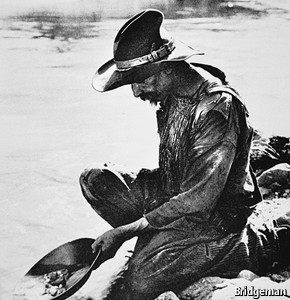 Do read The Economist’ excellent paper comparing the 19th Century gold rush to the present shale gas boom. The economic and social impact are about the same and local farmers are cooperating since they get large chuncks of the bonanza. Anyway it looks like that America in on the verge of becoming the largest gas producer, creating some 1.7M additional jobs.
Do read The Economist’ excellent paper comparing the 19th Century gold rush to the present shale gas boom. The economic and social impact are about the same and local farmers are cooperating since they get large chuncks of the bonanza. Anyway it looks like that America in on the verge of becoming the largest gas producer, creating some 1.7M additional jobs.
Sitting on a gold mine
The locals in 19th-century California were not consulted about the gold rush. Many Native Americans, who in previous decades had reached accommodations with Spanish and Mexican settlers, were murdered or infected with unfamiliar diseases. Scorched-earth offensives starved them off their land: since hunting them down was too time-consuming, one white soldier wrote, “It was therefore decided that the best policy was to destroy their huts and stores, with a view of starving them out.” Their descendants live in reservations. Williston’s natives are faring rather better.
Because they can drill sideways, frackers can suck out the oil and gas under a huge farm while disturbing only a tiny part of it. So the farmer carries on rearing cows as before. The fracking takes place so far underground that he never notices it. But he notices the royalties that the energy firms pay.
“Most farms round here have mineral income,” says Tom Rolfstad of the Williston Economic Development office. A farmer with two square miles of land will get a signing bonus of $2.5m and nearly 20% of the gross value of the oil and gas pumped from it, he estimates. A good well can keep producing for 30 years and yield 500,000 barrels of oil. At $100 a barrel, that’s $10m for the farmer. Even small landowners benefit. Mr Rolfstad gets regular little cheques for the oil and gas extracted below his modest home.
Many of the ancestors of today’s North Dakotans arrived at Ellis Island in the 19th century. “If you were Norwegian, they’d send you to North Dakota. If you didn’t speak English, they’d give you a card round your neck asking people to help you find the right train,” explains Mr Rolfstad. Under the Homestead Act of 1862, if the immigrants staked out 160 acres and farmed it for five years, they owned it—and their descendants own the mineral rights. In Europe, where such rights typically belong to the state, people resent the disruption fracking might cause. Americans, by contrast, tend to be delighted if a firm wants to frack under their land.
And for landowners, the fracking itself is not the only money-spinner. A farmer with land near Williston will have no trouble renting it out. The town is desperate for more offices, homes, shops and hotels. In one small field your correspondent counted 50 mobile homes.
One occupant, Cindy Martin, says the farmer charges her $1,000 a month to park there, with no electricity or water. “It’s a terrible price,” she complains. But the boom means labour is scarce and wages are high; Ms Martin makes twice as much as she would elsewhere, working at Bubba’s Bubbles. She and her husband drove up 2,000 miles from Arizona. She seems content: “We came here to work. We refuse to lay back and let the government take care of us. We’re too American for that.”
For all their good fortune, some locals fret about the crowding, pollution and change that accompany the new wealth. “It was a quiet, small town,” laments Gary Daniel, a middle-aged Willistonian, as he eats fried chicken at Gramma Sharon’s family restaurant. He has seen oil booms before, “but not like this one.” People used to know each other in Williston, he recalls: “Now everyone’s in a hurry to go nowhere.” Prices have soared. Mr Daniel knows of old people whose rent quadrupled so they had to leave their homes. “It’s flat-out greed,” he spits. The schools are packed; their walls are “just bulging out”. The traffic is “insane”. Overall, “whether it’s good or bad, I haven’t made my mind up.”
Mr Rolfstad has fewer doubts. Growth is being carefully planned, he says. “We decided to double the size of the town. Then we decided to quadruple it.